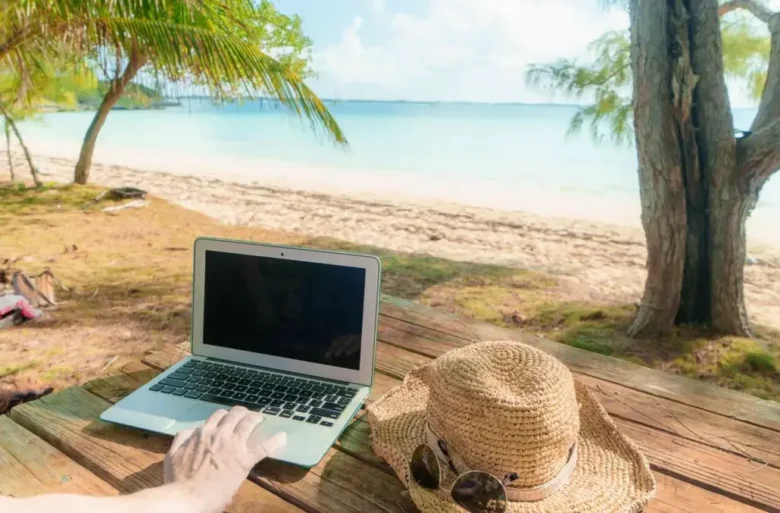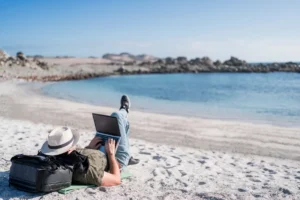Recently, the desire for independence, mobility, and the flexibility of remote work has fueled the rise of the digital nomad lifestyle. Laptops are a common sight in beach cafes and coworking spaces around the world, from Barcelona to Bali. On social media, this way of life might appear perfect, but for many digital nomads, burnout is a common occurrence. Time zone changes, isolation, excessive workloads, and frequent travel can negatively impact physical and mental health. To maintain the nomadic dream and prevent burnout, strategic planning combined with self-care is essential. This guide describes how to stay motivated and productive while traveling.
Understanding the Underlying Causes of Nomad Burnout:
Burnout in digital nomads takes time to develop. Repeated stress and a lack of adequate recovery can lead to a gradual worsening of the condition. Many nomads feel pressured to maximize their travel and work experiences, leading them to move at an unsustainable pace. Unreliable internet access, a lack of structure, and insufficient support systems make it easy to understand why emotional burnout is so common. Digital nomads often blur the lines between work and personal life, a stark contrast to office workers who leave their stress behind by 5 p.m. While constant “busyness” can feel exhilarating at first, it can gradually erode your mental resilience. The first step to preventing burnout is understanding its causes.
Prioritize Routine Even While Traveling:
Routine may seem paradoxical for free-spirited nomads, but it’s a crucial tool for preventing burnout. Amid the chaos of travel, routine offers stability and control. Establish a morning ritual before work, such as writing, meditating, or taking a walk. Avoid the temptation of working continuously simply because you can; instead, adhere to regular work schedules. Set consistent mealtimes, rest breaks, and bedtimes to get the most out of each day. These subtle routines can help you establish a rhythm and avoid indecisiveness, a hidden energy drain for digital nomads, even when your location changes.
Choose Destinations That Support Your Well-Being:
Not all nomadic locations are created equal. While trendy destinations like Medellín and Chiang Mai are popular, they aren’t for everyone. Some people need a quiet, natural environment to recover, while others thrive in a bustling metropolis. When choosing a location, consider your energy needs. Prioritize places with excellent Wi-Fi, a sense of community, proximity to yoga studios or gyms, healthy dining options, and mental health facilities. Slow travel, which involves staying in one place for a month or longer, helps you stay grounded and reduces the physical and mental stress of frequent moves.
Set Boundaries with Employers and Clients:
The lack of clear boundaries is one of the most overlooked factors contributing to burnout among remote workers. Don’t feel like you’re constantly on call just because you’re in a different time zone. Develop the ability to clearly explain your work hours to clients or employers and stick to them. Use tools like time zone converters and scheduling apps to organize meetings efficiently. The flexibility of remote work can also have its drawbacks; if you don’t set clear boundaries, you might find yourself working late into the evening or answering emails. Be as mindful of your spare time as you are of your money.
Build a Support Network While Traveling Abroad
Burnout can be significantly impacted by feelings of isolation, especially for single nomads. Without colleagues or familiar faces, loneliness can creep in, impacting your motivation and mental health. Building a support network in every location should be your top priority. Attend digital nomad meetups, join a coworking space, or connect through apps like Meetup, Bumble BFF, or Nomad List. Even short-term relationships are important; being able to laugh, talk, and connect with others going through similar situations can be incredibly healing. To maintain your emotional balance, consider regularly connecting virtually with friends back home or a therapist.
Travel Consciously and Integrate Work and Personal Life:
The goal of a digital nomadic lifestyle is to sustainably integrate work and personal life, not to work in paradise all day. By paying close attention to your surroundings, you can develop mindfulness. Don’t just post about your location; take time to appreciate it. Say no to incessant client calls or excessive travel. Make time for rest, creative activities, and hobbies. Remind yourself that you chose this lifestyle for balance, adventure, and personal development, not to avoid burnout. The goal is to thrive while traveling, not just to keep traveling.
Conclusion:
Booking flights and working from far-flung cafes are just two aspects of a nomadic lifestyle. It’s about creating a life that nourishes your long-term health and sustains your love of travel. Burnout, if left unaddressed, can transform a life of fantasy into a demanding reality. However, with self-awareness, a sense of community, boundaries, and purpose, it’s entirely possible to maintain mental clarity and creativity while traveling. Remember that the freedom you crave from this lifestyle also offers opportunities to relax, reset, and refocus. Pacing yourself is crucial to extending your digital nomad journey, as it’s a marathon, not a sprint.
FAQs:
1. What are the symptoms of digital nomad burnout?
Symptoms include chronic fatigue, lack of motivation, emotional exhaustion, difficulty concentrating, and feelings of disconnection or loneliness. If these symptoms persist, it’s crucial to reevaluate your daily routine and self-care practices.
2. How often should digital nomads relocate to avoid burnout?
While there’s no universal solution, slow travel (staying in one place for one to three months) often reduces stress and increases productivity. Frequent relocation can quickly lead to emotional fatigue and indecisiveness.
3. Are there specific tools that help digital nomads cope with burnout?
Meditation apps like Calm or Insight Timer can improve mental health, while programs like Notion, Trello, or Asana can help with task organization. Calendly and other scheduling tools can help manage time zones and avoid overbooking.
4. How do I maintain a social life while constantly on the go?
Join local events, coworking spaces, and digital nomad groups. Use apps like Meetup, Bumble BFF, or Facebook groups to find local events and stay social.
5. Is therapy available for digital nomads?
Yes, many online therapy websites, such as BetterHelp and Talkspace, offer remote counseling. Additionally, some therapists specialize in cultural adaptation therapy for expats and digital nomads via video chat.




